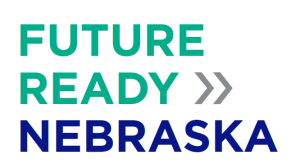Community Partnerships
Goals, Action Steps and Progress
| Recommended Action Step 1. Prepare several forms of Communication (PowerPoint, Flyers, Posters, Web Pages etc.) about the Digital Learning and Ed Tech plan for sharing at meetings and events so a consistent message is developed and shared with stakeholders. (Q2 2018, 2019, & 2020, NDE & FRNC) |
Recommended Action Step 2. Deliver presentations to several conferences, meetings and events to share the plan as widely as possible. (Q3 2018, 2019, 2020, NDE, ESUCC, ESU’s & FRNC)
Recommended Action Step 3. Future Ready Council members will meet with their legislative representative to share information about the Digital Learning and Ed. Tech plan and encourage support for its goals. (Q4 2018, 2019, 2020, FRNC)
Recommended Action Step 4. Explore options to host a statewide Future Ready Summit that would engage Nebraska educators and Nebraska education leaders. (Q4 2018, FRNC & NDE)
![]()
![]()
![]()
![]()
![]()
![]()
![]()
![]()
Recommended Action Step 1. Build relationships with Higher Ed and National organizations to promote the development of Computer Science education throughout Nebraska. (Q2 2018, Higher Ed. & NDE)
![]()
![]()
![]()
![]()
Using the Future Ready Goals and Action Steps
Each of the FRNC gear groups has written a comprehensive set of goals and provided recommended action steps supporting their goals to help move digital learning and education technology forward in Nebraska. To assist districts and schools in aligning their work to this plan, icons representing common state and national education initiatives were created and then aligned to each goal and action step. The table below gives guidance to each of the icons used and which initiative the icon represents. In many cases, the goals and action steps identified support work on multiple initiatives and each icon is shown to indicate these matches.
| This icon indicates that the Goal or action step is tied to an AQuESTT tenet or work that supports an AQuESTT tenet. | |
 |
This icon indicates that the Goal or action step is tied to ESSA either as a support of the act or because it is tied to available ESSA monies or grant opportunities. |
| This icon indicates that this Goal or action step is directly linked to a Goal or action step of another Future Ready Gear. | |
 |
This icon indicates that this Goal or action step is tied to a recommendation that is found within the 2017 National Education Technology plan. |
 |
This icon indicates that this Goal or action step supports a goal or advances the work of a Nebraska State Board of Education goal. |
Annual Timelines
| Community Partnerships 3 Year Timeline | ||||
| 2018 | ||||
| Q1: Jan. – March | Q2: April – June | Q3: July – Sept. | Q4: Oct. – Dec. | |
| CP1 Communication | AS 1. Develop Communication pieces and choose events to share | AS 2. Deliver Presentations and share the plan as widely as possible | AS 3. Meet with Legislators to share the plan details and goals & AS 4. Begin Future Ready Summit planning (2) | |
| CP2 Partnerships | ||||
| CP3 Exemplars | AS 1. Clearinghouse of community resources | |||
| CP4 Build Equity | AS 1. Build Computer Science relationships to promote the development of CS education. | |||
| Community Partnerships 3 Year Timeline | ||||
| 2019 | ||||
| Q1: Jan. – March | Q2: April – June | Q3: July – Sept. | Q4: Oct. – Dec. | |
| CP1 Communication | AS 1. Develop Communication pieces and choose events to share | AS 2. Deliver Presentations and share the plan as widely as possible | AS 3. Meet with Legislators to share the plan details and goals | |
| CP2 Partnerships | AS 1. Toolbox development on how to form partnerships and create opportunities. | AS 2. Creation of Community committees to execute current technology initiatives. | AS 3. Partnerships for preservice learning around digital learning best practices and pedagogy | |
| CP3 Exemplars | AS 2. Identify business and industries that benefit from an increase digital learning opportunities and share resources. | AS 3. Identify and develop opportunities and workplace experiences to provide career readiness skills in technology. | ||
| CP4 Build Equity | AS 2. Establish Communication channels to digital learnings stakeholders | AS 3. Continuously Engage stakeholder groups to communicate vision for obtaining access to technology for learning | ||
| Community Partnerships 3 Year Timeline | ||||
| 2020 | ||||
| Q1: Jan. – March | Q2: April – June | Q3: July – Sept. | Q4: Oct. – Dec. | |
| CP1 Communication | AS 1. Develop Communication pieces and choose events to share | AS 2. Deliver Presentations and share the plan as widely as possible | AS 3. Meet with Legislators to share the plan details and goals | |
| CP2 Partnerships | AS 4. Partnerships for sharing community resources amongst postsecondary, libraries etc. to enrich digital learning | AS 5. Partnerships with higher ed, college board and other for dual credit, AP courses and certifications | ||
| CP3 Exemplars | ||||
| CP4 Build Equity | AS 4.Identify stakeholder groups that can provide assistance to families in obtaining access | AS 5. Identify and create assistance to families for home access to technology for learning. | ||



